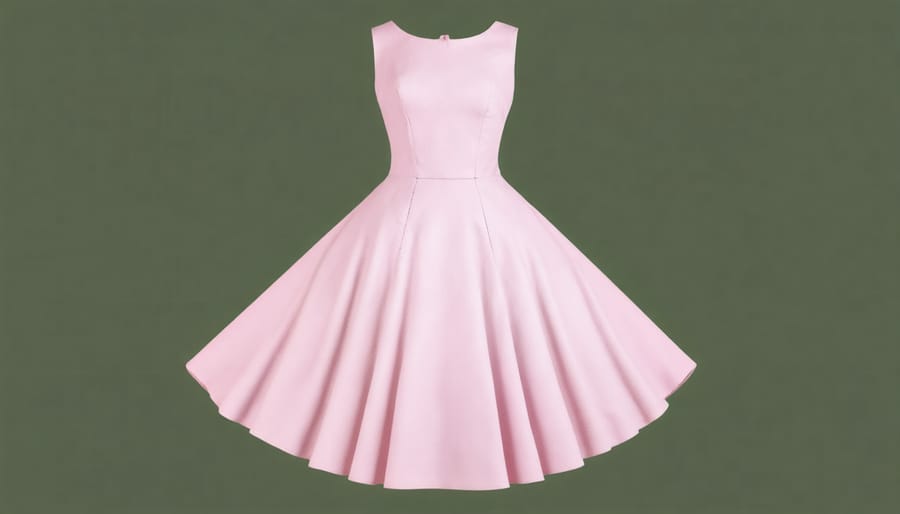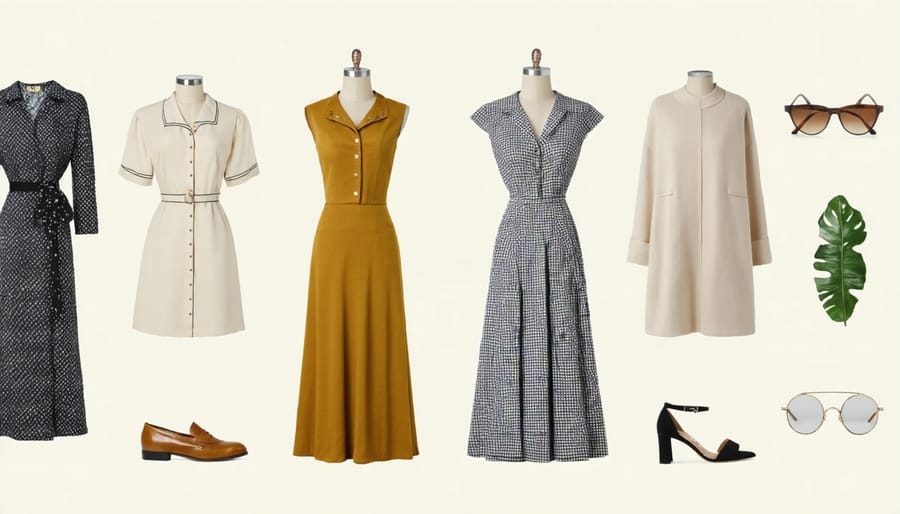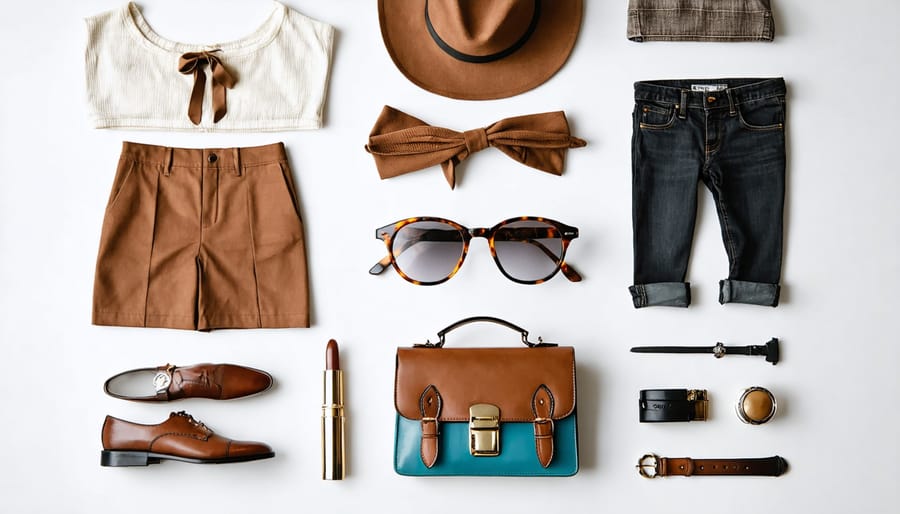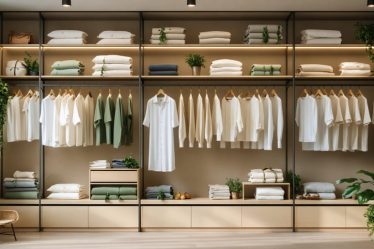
Step back in time to an era where elegance wasn’t just a choice – it was a way of life. The 1950s redefined sophistication through structured silhouettes, mindful accessorizing, and an unwavering attention to detail that modern fashion still celebrates today. While Dior’s New Look transformed waistlines and Audrey Hepburn’s grace captivated screens, the decade’s true legacy lies in its ability to blend timeless beauty with practical functionality.
Today’s revival of 1950s elegance isn’t about mere nostalgia; it’s a thoughtful response to fast fashion’s disposable culture. Modern women are rediscovering the power of well-chosen pieces, celebrating the era’s emphasis on quality craftsmanship and lasting style. From the perfect red lip to the carefully curated capsule wardrobe, 1950s-inspired elegance offers a sustainable approach to personal style that feels both fresh and familiar.
As we navigate our contemporary wardrobes, the principles of 1950s elegance – investing in quality pieces, mastering the art of accessorizing, and understanding the power of proper fit – provide a blueprint for creating enduring style that transcends trends. This isn’t just about looking back; it’s about moving forward with purpose, grace, and an appreciation for fashion that stands the test of time.
The Essence of 1950s Fashion Elegance
Silhouettes That Shaped an Era
The 1950s introduced silhouettes that continue to captivate fashion lovers today. The iconic “New Look,” popularized by Christian Dior, celebrated feminine curves with its nipped-in waists and full, voluminous skirts that required layers of petticoats. These dramatic proportions created the coveted hourglass figure that defined the era’s glamour.
For daytime wear, pencil skirts paired with fitted sweaters or tailored blouses became a staple, offering a sophisticated alternative to the fuller skirts. The “shirtwaist dress” – a fitted bodice with a flared skirt – emerged as the ultimate symbol of casual elegance, perfect for everything from grocery shopping to afternoon tea.
Evening wear took drama to new heights with form-fitting wiggle dresses that showcased curves, while butterfly sleeves and portrait necklines added romantic touches to formal attire. High-waisted pants, though less common, made their mark with wide-leg cuts that elongated the silhouette.
These timeless shapes weren’t just about looking pretty – they represented a post-war renaissance in fashion, celebrating abundance and femininity after years of fabric rationing. Today, these silhouettes continue to inspire modern wardrobes, proving that true elegance never goes out of style.

Fabrics and Patterns That Stand the Test of Time
The 1950s were defined by fabrics that perfectly balanced beauty with durability. Cotton was queen, appearing in everything from casual daywear to elegant party dresses. The era’s signature full skirts came alive in crisp cotton sateen and polished cotton, creating that unmistakable silhouette we all love. Silk and wool were reserved for special occasions, while nylon and rayon offered affordable alternatives that didn’t compromise on style.
When it comes to patterns, the 1950s gave us timeless designs that still captivate today. Polka dots, ranging from tiny spots to bold statements, were everywhere. Floral prints bloomed across summer dresses and blouses, while gingham checks added a touch of wholesome charm to everyday wear. For the more adventurous, novelty prints featuring everything from poodles to postcards injected personality into wardrobes.
What made these fabrics and patterns special wasn’t just their appearance – it was their quality. Garments were made to last, with sturdy seams and practical features that modern fashion could learn from. Even today, vintage pieces from this era often remain in remarkable condition, testament to the superior craftsmanship and materials of the time.
Sustainable Style Meets Vintage Charm

Why Vintage is the New Green
When we think about quality sustainable fashion, vintage clothing might not be the first thing that comes to mind. However, embracing 1950s fashion is actually one of the most eco-friendly style choices you can make. Every vintage piece you choose keeps one more item out of our landfills while reducing the demand for fast fashion production.
I discovered this myself when I inherited my grandmother’s carefully preserved cocktail dress from 1955. Not only did it tell a beautiful story, but it also opened my eyes to the incredible durability of vintage garments. These pieces were made to last, with quality materials and expert craftsmanship that often surpasses today’s mass-produced clothing.
By choosing vintage, we’re not just preserving history – we’re actively reducing our carbon footprint. The fashion industry is one of the world’s largest polluters, but when we shop vintage, we’re essentially recycling in the most stylish way possible. There’s no need for new resources, no additional manufacturing emissions, and no packaging waste.
Plus, vintage pieces often feature natural fibers like cotton, wool, and silk, which are biodegradable and more environmentally friendly than many modern synthetic materials. When we embrace these timeless pieces, we’re not just channeling the elegance of the 1950s – we’re making a conscious choice to protect our planet’s future while looking absolutely fabulous.
Quality Over Quantity: The 1950s Philosophy
In the 1950s, the approach to fashion was refreshingly different from today’s fast-fashion mentality. Women invested in quality pieces that would last for years, focusing on craftsmanship and timeless design rather than fleeting trends. This philosophy of “buy less, choose well” remains incredibly relevant today as we seek to build a sustainable wardrobe.
The emphasis was on selecting well-made garments with superior fabrics, precise stitching, and careful attention to detail. A typical 1950s wardrobe might contain fewer pieces than we’re used to today, but each item was thoughtfully chosen and impeccably maintained. Women would often develop relationships with local seamstresses and carefully inspect clothing before purchasing, checking for quality indicators like French seams, proper lining, and natural fabrics.
This mindful approach to fashion meant that clothes were seen as investments rather than disposable items. A single well-made dress could be styled differently for various occasions, and with proper care, would remain beautiful for years. The attention to quality extended beyond just the garments themselves – accessories were chosen with equal care, and proper storage and maintenance were considered essential parts of wardrobe management.
Today, we can learn much from this measured approach to fashion, incorporating these timeless principles into our modern wardrobes while staying true to our personal style.
Modern Styling Tips for 1950s Pieces
Mixing Vintage with Contemporary
Creating a harmonious blend of vintage and contemporary pieces is one of those timeless fashion secrets that can elevate your style to new heights. The key lies in striking the perfect balance – think of it as creating a conversation between past and present in your wardrobe.
Start by selecting one statement vintage piece as your anchor, such as a classic 1950s pencil skirt or a structured handbag. Then, pair it with modern elements that complement rather than compete. For instance, a vintage full skirt looks fresh when styled with a contemporary fitted turtleneck and minimalist accessories.
When mixing eras, pay attention to proportions. If you’re wearing a voluminous vintage dress, balance it with sleek modern shoes. Similarly, a classic 1950s cropped jacket can look incredibly current when paired with high-waisted wide-leg trousers and contemporary jewelry.
Color coordination is crucial – choose modern pieces in complementary shades that echo the tones in your vintage items. This creates a cohesive look that feels intentional rather than costume-like. Remember that vintage accessories can be the perfect finishing touch to a modern outfit, adding that special something that makes your ensemble uniquely yours.
Don’t be afraid to break traditional rules. A vintage brooch can add character to a modern blazer, while a classic 1950s belt can give structure to a flowing contemporary dress. The goal is to create looks that honor the past while embracing the present.
Accessorizing the 1950s Way
The art of accessorizing in the 1950s was all about creating a polished, put-together look that enhanced your outfit without overwhelming it. Think delicate pearl necklaces, dainty brooches, and perfectly matched glove-and-bag combinations that added just the right touch of sophistication.
For a true 1950s-inspired look, start with a classic string of pearls – real or faux – worn just above the collarbone. Layer with a subtle brooch pinned at the shoulder or collar of your dress or blouse. When it comes to earrings, small pearl studs or crystal clip-ons were the go-to choice for daytime wear.
Gloves were essential accessories during this era, with white or cream being the most versatile choices. For everyday wear, opt for wrist-length cotton or nylon gloves, saving your longer evening gloves for special occasions. Remember, gloves should be removed when eating, drinking, or applying makeup!
Handbags in the 1950s were structured and elegant – think top-handle bags in leather or patent. Choose neutral colors like black, navy, or brown to ensure versatility. For that extra authentic touch, match your shoes to your handbag, just as ladies did back then.
Don’t forget the finishing touches: a silk scarf tied gracefully around the neck or a classic wristwatch with a delicate band. These small details make all the difference in achieving that coveted 1950s elegance.

Making Vintage Work for Your Body Type
The beauty of 1950s fashion lies in its adaptability to different body types, and with a few clever styling tricks, you can make vintage silhouettes work beautifully for your shape. As you build your perfect wardrobe, consider these figure-flattering tips.
For hourglass figures, embrace the classic fit-and-flare dresses that defined the era. These naturally emphasize your waist while providing balanced volume in the skirt. If you’re pear-shaped, opt for full-skirted dresses with structured shoulders to create proportion, and don’t shy away from bold prints on top.
Apple shapes look stunning in 1950s swing coats and straight-cut dresses with subtle waist definition. Focus on vertical details and V-necklines to create length. For rectangular body types, try pencil skirts with peplum tops or circle skirts with fitted sweaters to create curves where desired.
Petite frames can rock vintage looks by ensuring proportions are scaled appropriately – think shorter hemlines and smaller prints. Taller figures can embrace longer pencil skirts and full-length swing coats with dramatic effect.
Remember, the key to wearing vintage isn’t about perfectly matching your body to period ideals – it’s about adapting these timeless styles to celebrate your natural shape. Many vintage pieces can be easily altered by a skilled tailor to achieve that perfect fit, making them even more special in your wardrobe.
Where to Find Your Perfect 1950s Pieces
Curated Vintage Shops vs. Thrift Stores
When hunting for authentic 1950s pieces, you’ll find yourself choosing between two main venues: curated vintage shops and traditional thrift stores. Each offers a unique shopping experience with its own set of advantages.
Curated vintage shops are like stepping into a carefully crafted time capsule. These boutiques have done the hard work for you, with experts hand-selecting quality pieces from the era. While prices tend to be higher, you’re paying for authenticity, condition, and convenience. The shop owners often have deep knowledge about the pieces’ history and can guide you in selecting items that truly capture 1950s elegance.
On the flip side, thrift stores offer the thrill of the hunt. You might need to dig through racks and visit multiple locations, but the reward can be finding genuine 1950s treasures at fraction of boutique prices. I once discovered a pristine 1950s circle skirt buried between modern clothing for just $12 – a piece that would easily fetch $100 in a vintage shop.
For beginners, I recommend starting with curated shops to familiarize yourself with authentic 1950s styles, construction, and materials. Once you’ve developed an eye for vintage pieces, venture into thrift stores armed with that knowledge. Many savvy vintage enthusiasts mix both approaches, visiting curated shops for special pieces while regularly thrifting for everyday finds.
Authentication and Quality Assessment
When hunting for authentic 1950s pieces, knowing what to look for can save you from costly mistakes. I learned this lesson firsthand when I excitedly purchased what I thought was a vintage dress, only to discover it was a modern reproduction. Now, I always start by examining the label – genuine 1950s garments often feature union tags, sizing marks written as numbers without letters, and brand names that reflect the era.
Pay attention to construction details: 1950s clothing typically features metal zippers, hand-finished hems, and pinked seams. The fabric quality is another telling sign – many vintage pieces were made with natural fibers like cotton, wool, and silk. Run your fingers along the material; authentic vintage fabrics often have a distinct texture and weight that’s hard to replicate.
For accessories, check for signs of age-appropriate wear and period-correct materials. Vintage handbags should have sturdy hardware, while jewelry from the era often features specific clasps and findings characteristic of the time.
Don’t shy away from asking sellers for detailed photos and provenance information. A reputable vendor will be happy to provide close-ups of labels, stitching, and any existing wear. Remember, some signs of age can actually authenticate a piece – perfect condition might indicate a reproduction.
When in doubt, consider consulting vintage fashion communities or experienced collectors. Their knowledge can be invaluable in making informed purchases and avoiding counterfeits.
The enduring charm of 1950s elegance speaks volumes about its timeless appeal. As we embrace sustainable fashion choices in our modern world, the quality-focused mindset of the 1950s offers valuable lessons. By investing in well-made pieces, embracing classic silhouettes, and learning to care for our clothes as they did in the past, we’re not just channeling vintage glamour – we’re making environmentally conscious choices. The decade’s emphasis on tailoring, repair, and wardrobe longevity aligns perfectly with today’s slow fashion movement. Whether you’re drawn to full skirts, perfectly fitted blazers, or elegant accessories, incorporating these elements into your wardrobe creates a lasting style that transcends trends. As we look forward while drawing inspiration from the past, the sophistication of the 1950s continues to influence and enhance our fashion choices, proving that true elegance never goes out of style.



